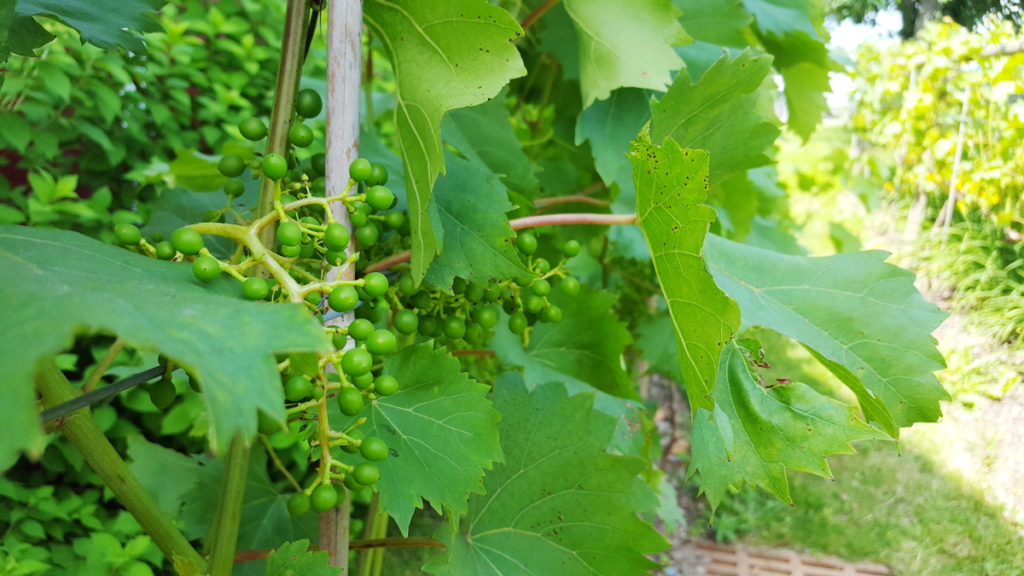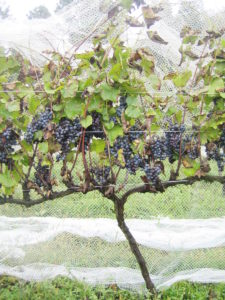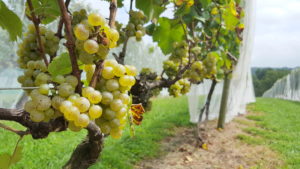
Photo by: Denise M. Gardner
Over the last two weeks, I introduced a question that was posed to me during a previous Darn Good Winemakers session and dived into some background about science. While I try to integrate the use of science with all of my clients, I think it’s important to have a reference of limitations and expectations that come with scientific research and commercial applications.
In parts 1 and 2 of our 3-part blog, I covered:
- Why I don’t make viticulture recommendations as an enologist.
- How to separate research findings and commercial application.
But today, I’m finally going to get to the meat of the question that was actually posed to me:
- Getting three viticulture expert opinions on cluster zone leaf removal techniques, and closing winemaker thoughts.
Since I cannot answer the question, I talked to three viticulture experts about their research or take on cluster zone leaf removal. Enjoy!
The viticulture experts
The question originally posed included research from a few universities. I managed to talk to two of those researchers, Dr. Michela Centinari from Penn State University and Dr. Cain Hickey from the University of Georgia. Both professors have several research publications that evaluate cluster zone leaf removal. Though, I think it’s worth mentioning that those evaluations were taken in various grape growing regions. While both researchers focus on vineyard research in the Eastern U.S., Michela’s vineyard sites are often affiliated with the Northeast or Mid-Atlantic, while Cain’s vineyard sites are often located in the Mid-Atlantic or South.
To round out the discussion, I also talked to Fritz Westover, founder of Westover Vineyard Advising. Fritz has a vast background in grape growing research and vineyard management. Today, he consults with grape growers in over five states throughout the U.S. He also manages the Virtual Viticulture Academy, an online interactive platform for growers to access practical and timely viticulture information.
Let’s hear what they had to say.
What is the general purpose of cluster zone leaf removal?
All three experts agreed: cluster zone leaf removal’s primary purpose is for grapevine disease control.
Michela: By opening up the canopy of leaves surrounding the clusters, spray penetration is increased and fruit or leaves can dry better after a rain.
Cain: Many of the grape growing regions exploring cluster zone leaf removal experience rainy seasons more than they experience hot, dry seasons. In this case, the grower utilizes techniques like cluster zone leaf removal to improve his/her chances at producing clean fruit. Leaf removal allows for better air movement around the cluster, better spray retention, and ultimately gives growers (and winemakers) more flexibility associated with picking choices.
Fritz: The number one reason to use cluster zone leaf removal is for disease control. Growers want to open up the fruit zone, especially with bunch rot varieties, to increase air flow and spray penetration.
But there may be additional benefits associated with cluster zone leaf removal. For example, Fritz indicated that red grape growers may be able to initiate a quicker reduction of methoxypyrazines, those aromatic compounds that cause green bell pepper aroma and flavor in the wine. Referencing research coming from Cornell, it’s possible that the increased sun exposure can help initiate that process sooner and reduce hang time needs. Michela and Cain added that increased in anthocyanins and phenolics in the fruit, which is beneficial for red varieties, may also be a contribution of cluster zone leaf removal practices.

Furthermore, Fritz also indicated that cluster zone leaf removal can be used as an insect control technique for those vineyards that experience high spotted winged drosophila (SWD) or grape berry moth (GBM) pressure. “Getting sprays fully applied to the fruit clusters is essential in these cases,” Fritz explains. Therefore, opening up the canopy with leaf removal allows good insecticide penetration, helping to minimize SWD or GBM damage.
While many openly discuss a lack of fruit chemistry changes, Cain’s research has almost always found a decrease in titratable acidity (TA) of the fruit, likely caused by malic acid respiration as a result of radiant heating. His research has shown TA changes in hotter regions of both Georgia and North Carolina. Cain has seen as much as 1 to 2 g/L decreases in fruit TA. Is that change always desirable by the grower? It depends on your winemaking goals, and if malic acid retention is desirable for the wine style.
In your professional opinion, do you think cluster zone leaf removal should be considered on a site-by-site and/or variety-by-variety basis?
Cain: Yes, cluster zone leaf removal techniques and recommendations are regional, site specific, and variety specific. They may even be block specific within a site. In general, I recommend that growers start [cluster zone leaf removal] with early budding varieties and then move onto later budding varieties that grant them more time to remove leaves at the right moment. Hybrid varieties tend to be a second priority after Vitis vinifera because they tend to have better disease resistance and due to the fact we don’t know if there are chemistry/sensory advantages to prioritizing hybrids over V. vinifera cultivars.
Michela: Cluster zone leaf removal techniques are regional and site specific, and recommendations are also cultivar specific.
Also she has noticed that cluster zone leaf removal seems most beneficial for red grape varieties. Commercial growers, however, will be more conservative for white grape varieties and expose less of the fruit.
Fritz tailors cluster zone leaf removal recommendations for each client that works with him. Decisions are based on the site, variety, and block, and then recommendations are customized to fit the needs of that grower and site.
In Pennsylvania, where Michela’s research is focused, there are climatic differences between the north and south ends of the state. Thus, cluster zone leaf removal recommendations also differ based on those regions.
Michela: The general recommendation I see from researchers is to proceed with caution when using cluster zone leaf removal techniques. Generally, pulling leaves from both sides of the canopy is not recommended in warm/hot regions. Furthermore, maybe only start out exposing 50-60% of the fruit instead of 100% fruit exposure if you’re unsure how this technique will affect your fruit. But it is important to expose fruit to sunlight early in the season, typically no later than berry “pea” size to reduce risk of sunburn in warm/hot climates.
The timing, extent, and magnitude of leaf removal appears to matter when it comes to cluster zone leaf removal. Both Cain and Fritz agreed with Michela, and discussed berry size as a good indicator as to whether or not cluster zone leaf removal will have detrimental effects in the vineyard. If berries are marble/pea sized, a grower has to be conservative on leaf removal (if done at all) because this is past the recommended time for leaf removal application.
Cain: When evaluating post-fruit set leaf removal, I remove leaves at the earliest I possibly can: when the berries are peppercorn-sized. If leaves are removed later, the berries are more susceptible to sun and heat damage because the berries haven’t been given enough time to accumulate the necessary compounds for defense. This later leaf removal often leads to some berry damage.
Are there downsides/risks associated with cluster zone leaf removal?
Cain: If leaves are removed before bloom, the grower risks crop yield reduction because he/she is reducing the carbon availability that the plant needs as a resource for fruit set. The other risk is removing leaves too late, and then there’s potential for sun or heat damage. But again, this will highly depend on the site and growing season.
Michela: Yes, there are potential risks. If the fruit temperatures get too high [usually designated at 35°C (95°F)], some research (from Washington state and Italy) has shown inhibition of anthocyanins and aromatic changes that can potentially cause negative effects on fruit and wine quality. Almost everyone agrees on removing leaves from the east-side of the canopy, as this is the side of the canopy that gets hit by morning sun and can help dry out the clusters and canopy quickly due to the increased exposure. Debate surrounds west-side leaf removal from the canopy, and how many leaves should be removed for a given site or region.

Photo by: Denise M. Gardner
Cain: In my opinion, I don’t fear removing leaves from the west side of the canopy. The typical indices they look for in research (i.e., phenolics, anthocyanins, etc.) were improved with west-side leaf removal in humid, eastern U.S. growing regions.
Cain also reiterated that perspective is based on the regions or vineyards he has worked in or works with today. How west-side canopy leaf removal impacts [wine] flavor, he is not sure. Some of Cain’s research has documented increased carotenoid development, which acts as an increase in the aromatic precursor pool. How that correlates to wine quality is a bit unknown.
Fritz, on the other hand, has a slightly different perspective.
Fritz: In wetter climates, including sites within Georgia or Virginia, I don’t typically worry about the late-afternoon sun side [west-side] of the canopy getting too much sun exposure if cluster zone leaf removal was done early enough. However, in hot, dry climates such as some sites in Texas and Arizona, I have seen some negative affects affiliated with cluster zone leaf removal, especially on the west-side of the canopy. Specifically, this can lead to berry sunburn, grape berry shrivel, and the fruit temperatures can go upwards of 15°F over ambient temperature, which can lead to cooked flavors.
Fritz emphasized leaf removal timing and how important it is to time it properly. He also encouraged growers to alter the degree (or, number of leaves removed) of cluster zone leaf removal based on the site and variety.
Fritz: If cluster zone leaf removal is done too late (by the time the berries are about pea sized), the berries are not only more susceptible to burn, but also physical bruising or damage.
Fritz has seen 60 mph wind and sand storms injure overly exposed berries in multiple ways. Furthermore, he’s found physical damage associated with workers being too rough pulling the leaves from the vine, which lead to scaring on the berries.
Despite these risks, all three experts emphasized evaluating the site, block, and variety; there is not one blanket solution when it comes to apply cluster zone leaf removal techniques.
Cain: Generally, rot on fruit is decreased with cluster zone leaf removal. We have to remember to ask winemakers what they want. Are they willing to risk sunburn? Do we know what sunburn does to the wine’s quality? Is it possible to adjust picking times to avoid over-ripened fruit? Generally, winemakers don’t want rot under any circumstances, and this technique is a way to minimize the influence of rot.
Michela: The grape growing regions in which we work have inherent seasonal variation. By the time growers have to pull leaves, no one knows how the remainder of the growing season will turn out. In this case, there is the risk of the unknown. However, for varieties with tight clusters and sensitive to rot, the advantages of cluster zone leaf removal are well-documented and will likely be worth the management investment for wine grape growers.
Fritz: I always remind growers facing rot-prone varieties or with those that face annual pressure from SWD or GBM, that the benefits of cluster zone leaf removal far outweigh the risks.
A winemaker’s thoughts on these viticulture answers.
As a winemaker, I have to agree with these experts:
- I would rather deal with clean fruit than rotted fruit, so I would feel comfortable working with growers that use practices to routinely reduce rot incidence. If a good vintage year follows, I’d recommend adjust the picking time for that wine grape variety.
- If rot is occurring in the vineyard, picking earlier can save fruit quality in most circumstances. Being flexible with picking times (instead of doing things out of habit) can make a huge difference with wine quality.
The winemaker’s role is to make something of the fruit they are given. For many of us, that means taking the good years with the bad years, and having realistic expectations from growers during each season.
I think the real challenge is understanding that our grape growing regions include natural variation, which means the wines are inherently varied. To me, that means avoiding recipe winemaking decisions and evaluating each batch of fruit that comes in, individually.
With each client I work with, we customize winemaking decisions to best emphasize the fruit and work towards the style of wine desired. However, even with those goals, it’s important to evaluate the fruit to assess if the winemaker is trying to fit a square peg into a round hole by forcing fruit into a wine it cannot naturally become.
